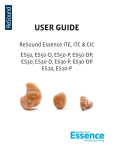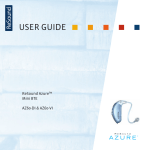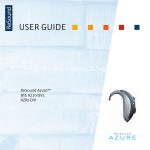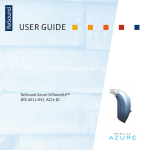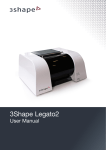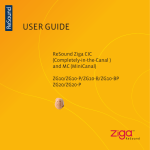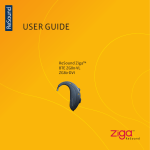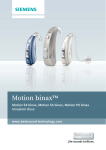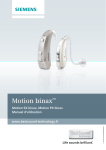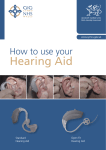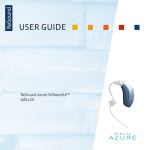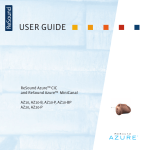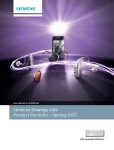Download ReSound ES70-DVI User guide
Transcript
user guide ReSound Essence BTE ES70-VI, ES70-DVI ES80-VI, ES80-DVI RESOUND Essence BEHIND-THE-EAR PERSONAL HEARING SYSTEM Congratulations on the purchase of your new fully-digital GN ReSound hearing instrument! This booklet describes the features available for the BTE(BehindThe-Ear) models in the ReSound Essence product line. The available options depend on the hearing instrument model; your hearing care professional will highlight the features of your particular hearing instrument. GN ReSound’s advanced technology and customized programmes, selected by your hearing care professional, will offer you the best possible hearing solution to maximize listening situations in your family life, your professional life and your social life. Your hearing instrument has been adjusted for your individual hearing loss. Please familiarize yourself with the information in this booklet. Proper understanding and use of your new GN ReSound hearing instrument will allow you to derive maximum hearing benefit. This instruction covers the following ReSound Essence BTE products: ES70-VI, ES70-DVI, ES80-VI and ES80-DVI This booklet & your instrument In this booklet you will find instructions for inserting, using and caring for your new hearing instrument. Contents page Your ReSound Essence Hearing Instrument . . . . . . . . . . . . . . . . . . . . 4 On/Off Function . . . . . . . . . . . . . . . . . . . . . . . . . . . . . . . . . . . . . . . . . . . . . . . . . 5 Low Battery Warning . . . . . . . . . . . . . . . . . . . . . . . . . . . . . . . . . . . . . . . . . . . . 6 Changing the Battery . . . . . . . . . . . . . . . . . . . . . . . . . . . . . . . . . . . . . . . . . . . . 7 Battery Warning Information . . . . . . . . . . . . . . . . . . . . . . . . . . . . . . . . . . . 8 Inserting and removing the Instrument . . . . . . . . . . . . . . . . . . . . . 9-11 Recognizing Left & Right instrument . . . . . . . . . . . . . . . . . . . . . . . 12-13 Volume Control . . . . . . . . . . . . . . . . . . . . . . . . . . . . . . . . . . . . . . . . . . . . . . . . . 14 Programme Selector . . . . . . . . . . . . . . . . . . . . . . . . . . . . . . . . . . . . . . . . . . . . 15 Your Programme Environments . . . . . . . . . . . . . . . . . . . . . . . . . . . . . . . . 16 Directionality . . . . . . . . . . . . . . . . . . . . . . . . . . . . . . . . . . . . . . . . . . . . . . . . . . . 16 T-programme . . . . . . . . . . . . . . . . . . . . . . . . . . . . . . . . . . . . . . . . . . . . . . . . . . . . 17 Hearing through Induction loop . . . . . . . . . . . . . . . . . . . . . . . . . . . . . . . 18 Direct Audio Input (DAI) . . . . . . . . . . . . . . . . . . . . . . . . . . . . . . . . . . . . . . 19-20 Daily Maintenance . . . . . . . . . . . . . . . . . . . . . . . . . . . . . . . . . . . . . . . . . . . . . . 21 Cleaning the Ear Mould . . . . . . . . . . . . . . . . . . . . . . . . . . . . . . . . . . . . . . . . . 22 Cleaning the sound tube & dome . . . . . . . . . . . . . . . . . . . . . . . . . . . 23-24 Repairs . . . . . . . . . . . . . . . . . . . . . . . . . . . . . . . . . . . . . . . . . . . . . . . . . . . . . . . . . . 24 General Precautions . . . . . . . . . . . . . . . . . . . . . . . . . . . . . . . . . . . . . . . . . . . . 25 Troubleshooting Guide . . . . . . . . . . . . . . . . . . . . . . . . . . . . . . . . . . . . . . 26-27 Technical Data . . . . . . . . . . . . . . . . . . . . . . . . . . . . . . . . . . . . . . . . . . . . . . . . . . 28 Key Word Index . . . . . . . . . . . . . . . . . . . . . . . . . . . . . . . . . . . . . . . . . . . . . . . . . 29 ReSound Essence is a trademark of GN ReSound. 2 3 Your ReSound Essence ES70-VI/DVI and ES80-VI/DVI Hearing Instruments Tone tube Microphone behind cover Volume wheel Plastic tube Programme button Battery door Ear mould Turning on and off Your ReSound Essence BTE is equipped with an on/off switch integrated into the battery compartment. Turn your hearing instrument on by closing the battery door. Turn your instrument off by opening up the battery door. When first turned on, your hearing instrument will always start in programme 1. off To read more on this subject, turn to page 15. Your ReSound Essence ES70 ThinTube Hearing Instruments Tone tube Microphone behind cover Volume wheel Plastic tube Programme button Battery door Mini dome 4 • Turning your instrument off when you are not using it will increase the battery life. • At night, turn off your instrument and open the battery door completely. It will allow moisture in your instrument to evaporate and will increase the instrument’s life span. 5 Low Battery Warning Changing the Battery The hearing instrument has a soft low-battery-warning signal (beep-beep) that you will hear when the battery voltage/power gets too low. The signal indicates you should replace the battery. We recommend that you always carry a spare battery with you. The low-battery-warning signal will be repeated every 5-10 minutes until the battery runs out of power. The instrument will then automatically switch off. Open the battery compartment completely, using your fingernail to pull back on the small ridge located at the top of the door. After removing the old battery, insert the new one with the“+” (flat) side facing the “+” on the battery door. Make sure the battery has been placed correctly into the slot. The battery door should close very easily. Never use force to close the door as this may damage your hearing instrument. ES70 & ES80 Always use a size 13 Zinc-Air battery. Please note that if the battery is weak, the hearing instrument performance will be reduced. Removing the battery when you are not wearing the instrument will help prevent corrosion of the battery contacts and prolong battery life. 6 7 Battery Warning Information Inserting your instrument (ES70 and ES80 - with ear mould) Batteries contain dangerous substances and should be disposed of carefully in the interest of your safety and for the environment. • Open the battery door to turn the instrument off. Hold the ear mould between your thumb and index finger and position its ‘point’ in your ear canal. Now, slide the ear mould all the way into your ear with a gentle, twisting movement. Insertion can be easier if you gently pull your ear back with your other hand. • Turn the top-part of the ear mould gently backwards and forwards so that it fits behind the fold of skin above your ear canal. • Place the hearing instrument behind your ear. Move the ear mould up and down and press gently to ensure it is positioned correctly in the ear. Open ing and closing your mouth can ease insertion. • When properly inserted, it is important that your earmould fits comfortably and tightly in your ear. If your earmould irritates your ear in any way and prevents you from wearing your hearing instrument, please contact your hearing care professional to have the earmould modified. You should never attempt to modify the shape of the custom earmould yourself. • Do NOT attempt to recharge batteries which are not specifically designated rechargeable as they may leak or explode. • Do NOT attempt to dispose of batteries by burning them. • Keep batteries away from small children and pets. • Do NOT place batteries in your mouth. If swallowed, seek immediate medical attention. 8 9 • When correctly positioned turn on your instrument by closing the battery door. Inserting your instrument (ES70 with ThinTube) • Position the instrument over the top of your ear. • Grasp the ThinTube where it bends and push the dome into your ear canal. The dome should be placed far enough into the ear so that the sound tube lies flush with your head. When the dome is placed appropriately, you should not see the ThinTube sticking out when you look directly into a mirror. Removing your instrument (ES70 and ES80) • Turn off the instrument by pressing the battery door in the ‘off’ position. • Lift the hearing instrument from behind the ear. For a moment, let it hang beside your ear. • Using your thumb and index finger, gently pull the earmould (not the instrument or the tubing) loose from the ear. • Remove the earmould completely by gently twisting it. • If the device whistles, the most likely reason is that the dome is not placed correctly in the ear canal. Other reasons can be buildup of earwax in the ear canal, or that the sound tube connection to the instrument has become loose, in which case the sound tube must be changed. It is also possible that the instrument settings are not optimal. If you have ruled out other reasons for the instrument squealing, it is recommended that you contact your hearing care professional. • It is important that the ThinTube and the dome fit correctly into your ear. If the ThinTube or the dome irritate your ear in any way and prevent you from wearing your hearing instrument, please contact your hearing care professional. You should never attempt to modify the shape of the ThinTube yourself. 10 11 Recognising left and right instrument If you have two hearing instruments, they may be set differently. One for your left ear, the other for your right. Do not switch them. Please pay attention to this when cleaning, storing and inserting the instruments. ES70, ES70 open & ES80 indication ES70 & ES80 with Ear mould • If your hearing care practioner has not already done so, you can ask him/her to mark your instruments with a coloured Left and Right indication: Left is blue and Right is red. left right left right ES70 open 12 13 Volume Control Programme Selector All the ReSound Essence models have a volume control which allows you to set and control the volume manually. The volume wheel has numbers on it from 1 to 4, with 4 being the maximum volume setting. During the fitting of the hear ing instrument, your hearing care practitioner will select an optimal volume setting for you. Please note the setting of that particular level. To increase the volume with the instrument fit to your ear, turn the volume control wheel up. To reduce the volume, turn the wheel down. Your hearing instrument has a push button allowing you to use up to three different listening programmes, each of them suitable for certain situations. Please note that your instrument has been fit by your hearing care professional and that your hearing loss requires a certain amount of amplification. This will also effect how much you are able to increase the volume on your instrument. • If you prefer not to use the volume wheel your hearing care practitioner can disable the volume control. Your hearing care professional has most likely programmed multiple programmes into your instrument. You can select programmes simply by depressing the programme selector once You will then hear one, two or three “beeps”, indicating which programme you have selected. Your hearing instrument will switch programmes as follows: Examples: • If you have at least 2 programmes you would automatically start in the default programme, programme 1, press the programme button once to get to programme 2. You will hear 2 beeps when you are in programme 2 • If you have 3 programmes: Press the programme button twice to get to programme 3. You will hear 3 beeps when you are in programme 3. You can always return to programme 1 by turning your instrument off and then on again. 14 15 Your Programme Environments T-programme (Telecoil programme) Let your Hearing Care Professional fill out the following table: Your hearing instrument has a built in function, the telecoil, which can enable you to hear better on the telephone and in churches or halls that have an induction loop system installed in them. In order to activate this function, the telecoil programme has to be selected. In this programme you typically will hear no sounds from the microphone, therefore most environmental sounds will be lost. If you wish, your hearing care practitioner can change the setting in such a way that you hear the microphone and the telecoil simultaneously. No. Programme Description of when to use programme Type Directionality Certain ReSound Essence BTE instruments are equipped with two microphones and offer directionality. This is a function designed to help you hear speech better in noisy situations. This feature works best when the person speaking to you is in front of you and the noise is behind you. The hearing instrument actually attempts to reduce noise coming from behind you. Ask your hearing care professional if you have this option available on your hearing instrument. Using the telephone with induction loop. • Switch your instrument to the telecoil programme. • Hold your telephone handset behind your ear, close to the hearing instrument (2-3 cm.) and slightly tilt the receiver outwards. • Listen to the dial tone and move the handset a little to find the position that gives the best reception. • If needed, turn the volume up or down. • After completing the phone call, switch your instrument back to the microphone programme. If the phone you are using has a poor telecoil signal, use programme 1 instead. Do not hold the handset too tightly against your ear since this might cause ’whistling’. 16 17 Hearing through an induction loop Direct Audio Input (DAI) Many public places, churches, theatres and cinemas, have induction loop systems. In these particular rooms, the in duction loops transmit, wirelessly, the sound of the presenter or show. At home, radio or television can be connected to an induction loop system. Sound quality through an induction loop is often better because noise from the environment is not amplified. The ReSound Essence models all offer you the possibility of direct, uninterrupted connection to external devices such as television, radio and remote microphone via the Direct Audio Input socket. Often, this will improve sound quality. ES70 ThinTube, ES70-VI, ES70-DVI, ES80-VI & ES80-DVI • Switch your instrument to the telecoil programme. • Choose a good location. Reception is not clear in all locations; it depends on the position of the induction loop. Watch for signs or try a different seat yourself. • If necessary, adjust the volume up or down. • After the service or show, switch your instrument back to your standard programme. You will now hear through the microphone again. • If the sound in the telecoil programme is in general very soft or very loud, ask your hearing care practitioner to adjust the program accordingly. • The sound source is connected to your instrument with a cable or a wireless FM system to the audio shoe. The audio shoe will connect with a “click” to the hearing instrument but needs to be switched manually to Direct Audio Input via the programme selector. • Your hearing care practitioner will gladly provide you with advice regarding an induction loop system at home. Ask for it. 18 19 • The hearing instrument practioner will set one of your programmes for audio input. To use this feature set the instrument to that particular programme. • In this programme you will typically not hear any sound from the microphone, therefore most environmental sounds will be lost. If you wish, your hearing care practitioner can change the setting in such a way that you hear the microphone and the direct audio input simultaneously. Safety regulations External equipment, connected to the mains and to the audio input must comply with these safety regulations: IEC-65, IEC-601 or comparable. Daily Maintenance Keep your hearing instrument clean and dry. Wipe the case with a soft cloth or tissue after use to remove oil or moisture. If the instrument has been exposed to high humidity or perspiration, enclose it (with the ear mould) in a sealed container together with a drying agent (desiccant) overnight. Consult your hearing care professional concerning which drying agent to use. To avoid the need for unwarranted repairs: • Never immerse the instrument in water or other liquids since this may cause permanent damage to the circuitry. • Protect your hearing instrument from rough handling, and avoid dropping it on hard surfaces or floors. • Do not leave the instrument in or near direct heat or sunlight since excessive heat can damage the instrument or casing. 20 21 Cleaning the earmould • First, remove the tubing and earmould from the hearing instrument. Keep left and right instrument separated. • Remove earwax with the clean ing brush and a soft cloth. If needed, use a mild solution of soft soap and water or a special cleaning solution. Ask your hearing care practitioner for detailed instructions. • Rinse the earmould with water. Note: Do not use water or other liquid on the hearing instrument itself. • Dry the earmould with a cloth. • Remove water drops from tubing and earmould. A special device is available for this from your hear ing care practitioner. • Ensure that the earmould and tubing are completely dry before attaching them to the hearing instrument. Make sure that you connect the correct earmoulds to their corresponding instruments. Check the figures on page 11. Cleaning the sound tube and dome for ThinTube The ThinTube The ThinTube feeds the amplified sound from the hearing instrument into the ear. The ThinTube and the dome should be cleaned regularly. Remove the ThinTube from the instrument before cleaning by unscrewing it. Use a damp cloth to clean the ThinTube and dome on the outside and use the black cleaning rod to “push” any debris out of the sound tube. The cleaning rod should be inserted where the ThinTube attaches to the instrument and pushed all the way through the ThinTube and out through the dome. Do not submerge or rinse the ThinTube and dome with water, as there is a risk that a water drop may become lodged in the ThinTube. If this should occur, it will prevent sound coming through the ThinTube, and may be harmful for the instrument’s electronics. Replacing the tube The ThinTube and dome should be changed every third month or sooner if the ThinTube becomes stiff or brittle. We recom mend that you have your hearing care professional change the dome for you. If your hearing care professional instructs you to change the domes yourself, make sure that they are securely fastened to the ThinTube before inserting them in your ear. Ask your hearing care practitioner to replace the earmould tubing if it becomes stiff or changes colour. Failure to change the domes in accordance with the instructions could result in injury. 22 23 Repairs General Precautions If your GN ReSound hearing instrument malfunctions, it must be repaired by a qualified technician. Do not attempt to open the case of the hearing instrument since this would invalidate the warranty. If your GN ReSound hearing instrument requires service, please contact your hearing care professional for assistance. • Consult a physician if you find a foreign object in your ear canal, if you experience skin irritation or if excessive earwax accumulates with the use of the hearing instrument. • Different types of radiation, e.g. from NMR, MRI or CT scanners, may damage the hearing instrument. Therefore, do not wear the hearing instrument during these or other corresponding scanning procedures. Other types of radiation (burglar alarms, room surveillance systems, radio equipment, mobile telephones, etc) contain less energy and will not damage the hearing instrument. They could however momentarily affect the sound quality or create strange sounds from the hearing instruments. • Warning: Do not wear the hearing instrument in mines or other explosive areas, unless those areas are certified for hearing instrument use. • Warning to hearing care practitioners Special care should be exercised in selecting and fitting hear ing instrument(s) whose maximum sound pressure level exceeds 132 dB SPL with an IEC 60711: 1981occluded ear simulator, because there may be a risk of impairing the remaining hearing of the hearing instrument user. 24 25 TROUBLESHOOTING GUIDE SYMPTOM CAUSE POSSIBLE REMEDY No sound • • • • • Not turned on Dead battery Battery improperly inserted Blocked ear mould or tube Blocked sound outlet filter • • • • • Turn on Replace battery Insert battery properly Clean ear mould or tube blockage Change filter or consult your hearing care professional Not loud enough • • • • • • Loose ear mould Blocked ear mould or dome Change in hearing Excessive ear wax Blocked sound outlet filter Volume set too low • • • • • • Reinsert carefully Clean ear mould or dome Consult your hearing care professional Consult your physician Change filter or consult your hearing care professional Consult your hearing care professional Whistles • Loose ear mould • DFS needs re-initialization • Remove and reinsert • Consult your hearing care professional Sound not clear or distorted • • • • • • • • Weak battery Poorly fitting ear mould or dome Hearing instrument damaged Hearing instrument settings not optimal Replace battery Consult your hearing care professional Consult your hearing care professional Consult your hearing care professional If you experience additional problems not addressed in this guide, please contact your hearing care professional. 26 27 Technical Data Key Word Index Maximum Output (2cc Coupler / IEC 60118-7) Audio shoe . . . . . . . . . . . . . . . . . . . . . . . . . . . . . . . . . . . . . . . . . . . . . . . . . . . . . . . 19 Battery change . . . . . . . . . . . . . . . . . . . . . . . . . . . . . . . . . . . . . . . . . . . . . . . . . . . 7 ES70 open 118 dB SPL (Typical) Battery compartment . . . . . . . . . . . . . . . . . . . . . . . . . . . . . . . . . . . . . . . 5, 6, 7 ES70-VI 124 dB SPL (Typical) Cleaning the instrument . . . . . . . . . . . . . . . . . . . . . . . . . . . . . . . . . . . . 22, 23 ES70-DVI 124 dB SPL (Typical) Directionality . . . . . . . . . . . . . . . . . . . . . . . . . . . . . . . . . . . . . . . . . . . . . . . . . . . . 16 Direct audio input (DAI) . . . . . . . . . . . . . . . . . . . . . . . . . . . . . . . . . . . . . . 15, 19 Ear Mould . . . . . . . . . . . . . . . . . . . . . . . . . . . . . . . . . . . . . . . . . . . 9, 12, 21, 26, 27 ES80-VI 137 dB SPL (Typical) ES80-DVI 137 dB SPL (Typical) Environmental programmes . . . . . . . . . . . . . . . . . . . . . . . . . . . . . . . . 15, 16 Low battery warning . . . . . . . . . . . . . . . . . . . . . . . . . . . . . . . . . . . . . . . . . . . . . 6 Maintenance . . . . . . . . . . . . . . . . . . . . . . . . . . . . . . . . . . . . . . . . . . . . . . . . . . . . . 21 On/off switch . . . . . . . . . . . . . . . . . . . . . . . . . . . . . . . . . . . . . . . . . . . . . . . . . . . . . 5 Precautions . . . . . . . . . . . . . . . . . . . . . . . . . . . . . . . . . . . . . . . . . . . . . . . . . . . . . . 25 Programme Selector . . . . . . . . . . . . . . . . . . . . . . . . . . . . . . . . . . . . . . . . . 15, 19 SmartStart . . . . . . . . . . . . . . . . . . . . . . . . . . . . . . . . . . . . . . . . . . . . . . . . . . . . . . . . 6 Technical data . . . . . . . . . . . . . . . . . . . . . . . . . . . . . . . . . . . . . . . . . . . . . . . . . . . 28 Telecoil use . . . . . . . . . . . . . . . . . . . . . . . . . . . . . . . . . . . . . . . . . . . . . . . . 15, 17, 18 Telephone use . . . . . . . . . . . . . . . . . . . . . . . . . . . . . . . . . . . . . . . . . . . . . . . . 25, 17 ThinTube . . . . . . . . . . . . . . . . . . . . . . . . . . . . . . . . . . . . . . . . . . . . . . . . . . 23, 24, 10 Troubleshooting guide . . . . . . . . . . . . . . . . . . . . . . . . . . . . . . . . . . . . . . . 26-27 Volume control . . . . . . . . . . . . . . . . . . . . . . . . . . . . . . . . . . . . . . . . . . . . . . . . . . . 9 28 29 30 31 Worldwide Headquarters GN ReSound A/S Lautrupbjerg 7 DK-2750 Ballerup, Denmark Tel.: +45 45 75 11 11 Fax: +45 45 75 11 19 www.resound.com United Kingdom GN ReSound Ltd. 1 Landscape Close Weston Business Park Weston-on-the-Green Oxon OX25 3SX Tel.: 0 1869 352 800 Fax: 0 1869 343 466 www.gnresound.co.uk Australia GN ReSound Pty. Ltd. Unit R1 Regent Park Estate 391 Park Road Regent Park NSW 2143 Tel.: (free) 1800 658 955 Fax: 02 9743 7472 www.gnresound.com.au New Zealand GN ReSound (NZ) Ltd. 12 Parkway Drive Mairangi Bay Auckland Tel.: (free) 0800 900 126 Fax: (free) 0800 007 695 www.gnresound.co.nz 16715700-GB-08.01 Rev.A Any issues relating to the EU Medical Device Directive 93/42/EEC should be directed to GN ReSound A/S.

















